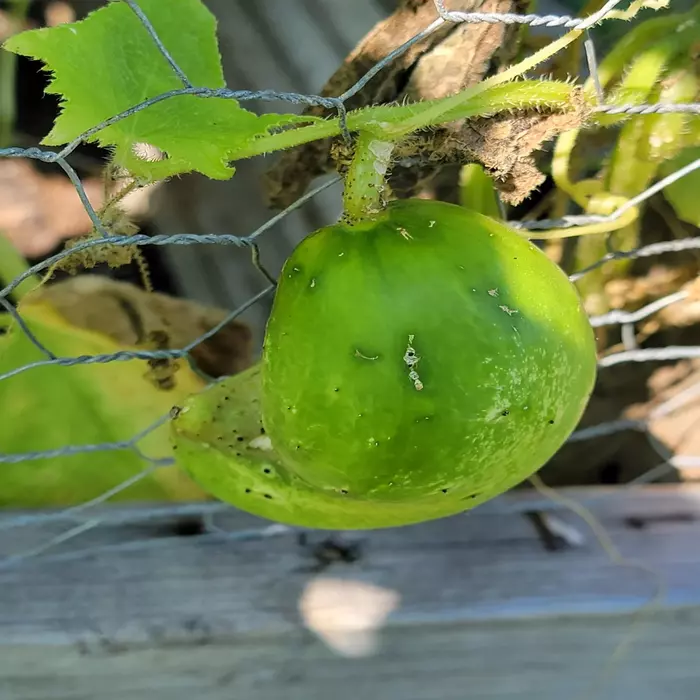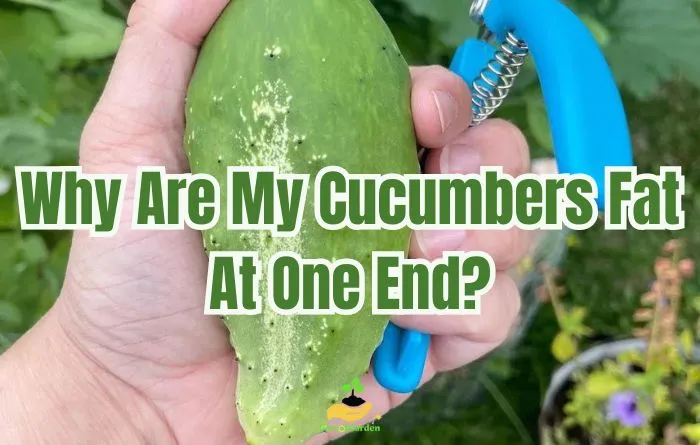Why Are My Cucumbers Fat At One End? [4 Reasons Explained]
Ever pulled a cucumber from your garden, only to find it plump at one end and skinny at the other? Wonder no more! In my latest blog post, “Why Are My Cucumbers Fat at One End?”, I dive deep into the mysteries of cucumber growth. Discover the root causes, gardening secrets, and pro tips to ensure your cucumbers grow uniformly
Key Takeaways:
- Insufficient pollination can result in cucumbers developing fat ends.
- Improper watering practices, such as overwatering or underwatering, can affect cucumber growth and contribute to fat ends.
- Hot temperatures can impact cucumber growth and lead to dehydration, potentially causing fat ends.
- Excessive use of nitrogen-based fertilizers can lead to deformed cucumbers with fat ends.
- To address fat ends on cucumbers, you can attract pollinators to your garden, hand-pollinate the flowers, provide proper watering, and avoid overusing fertilizers.
Causes of Fat Ends on Cucumbers
There are several factors that can contribute to cucumbers developing a fat end while the other end remains smaller. Understanding these causes can help gardeners like you take the necessary steps to prevent this issue and ensure healthy cucumber growth.
| Causes of Fat Ends on Cucumbers | Prevention Measures |
|---|---|
| 1. Insufficient pollination | Attract pollinators by planting pollinator-friendly flowers, provide water sources and shelter |
| 2. Improper watering | Provide consistent and appropriate watering, mulch to retain moisture |
| 3. Hot temperatures | Provide shade or use shade cloth to protect plants from excessive heat |
| 4. Excessive use of nitrogen-based fertilizers | Follow recommended application rates, use balanced, organic fertilizers |
1. Insufficient Pollination
From my experience, the first cause of cucumbers being fat at one end is insufficient pollination, where the female flowers do not receive enough pollen from the male flowers. This can happen if there is a lack of pollinators like bees and butterflies in the garden.
Pollination is crucial for the formation of well-shaped cucumbers. When the female flowers are not properly pollinated, they may develop into deformed cucumbers with a fat end. Without sufficient pollen transfer, the fruit fails to develop evenly, resulting in an imbalanced shape.
Solution
To ensure proper pollination I always try to draw the attention of pollinators to my garden, and you should do the same.
I usually plant flowers like lavender, marigolds, and sunflowers that are known to attract bees and butterflies. By providing a diverse range of nectar-rich plants throughout the growing season can also support a healthy population of pollinators.
But if you do not manage to get enough pollinators in your area or if you want to ensure thorough pollination, you can consider hand-pollinating your cucumber plants.
This process involves transferring pollen from the male flowers to the female flowers using a small brush or cotton swab. By manually transferring the pollen, you can overcome the challenge of insufficient pollination and promote the development of balanced cucumbers.
| Steps for Hand-pollination: |
|---|
| 1. Identify the male and female flowers. Female flowers have an immature cucumber at the base, while male flowers have a long, slender stem. |
| 2. Gently remove a male flower from the plant. |
| 3. Carefully brush the stamen of the male flower against the stigma of the female flower, transferring the pollen. |
| 4. Repeat this process for multiple flowers to ensure comprehensive pollination. |
2. Inconsistent Watering
The second reason I know cucumbers have fat ends is inconsistent watering, which can lead to a lack of moisture and nutrients for the cucumbers to develop properly.
Overwatering or underwatering can disrupt the delicate balance required for cucumber growth. When plants are overwatered, the excess moisture can cause the roots to become waterlogged, resulting in poor nutrient absorption and stunted growth.
On the other hand, underwatering can deprive the plants of essential moisture, causing them to wilt and become stressed.
Solution
Proper watering techniques are crucial for preventing fat ends on cucumbers. One method I use is to water deeply and infrequently, allowing the soil to dry out slightly between waterings.
This helps to promote deep root growth and prevents the formation of fat ends. Additionally, using mulch around the cucumber plants can help to retain soil moisture, reducing the risk of underwatering.
| Watering Do’s | Watering Don’ts |
|---|---|
| Water deeply and infrequently | Overwatering |
| Allow soil to dry out slightly between waterings | Underwatering |
| Use mulch to retain soil moisture | Ignoring signs of plant stress |
3. Hot Temperatures
Hot temperatures can have a negative impact on cucumbers, affecting their ability to properly develop and resulting in fat ends. When exposed to prolonged periods of high heat, cucumbers can experience dehydration, which hinders their growth and can cause irregularities in their shape.
The heat can also disrupt the natural pollination process by reducing the activity of pollinators like bees and butterflies.
During hot weather, cucumbers may struggle to retain enough moisture, leading to decreased water uptake and nutrient absorption. This can result in stunted growth and the development of fat ends on the fruit.
Additionally, the heat can cause a decrease in flower production, further impacting the chances of proper pollination.
Solution
To mitigate the negative effects of hot temperatures, here are the steps I take.
Providing shade or building temporary covers can help protect the plants from direct sunlight during the hottest parts of the day.
Mulching around the cucumber plants can also aid in retaining soil moisture and regulating temperature.
Additionally, ensuring an adequate water supply through regular watering, especially during the early morning or late evening when temperatures are cooler, can help keep the plants hydrated.
| Tip: | Placing a shallow dish with water near the cucumber plants can provide a water source for pollinators and encourage their presence in the garden, aiding in the pollination process. |
|---|
By creating a favorable environment for the cucumbers, you can minimize the impact of hot temperatures and increase the chances of obtaining uniform and properly developed cucumbers without fat ends.
4. Excessive Use of Nitrogen-based Fertilizers
Lastly, the excessive use of nitrogen-based fertilizers can cause cucumbers to grow abnormally, resulting in deformed shapes with fat ends.
Everyone knows that nitrogen is an essential nutrient for plant growth, but if you apply it excessively, it can disrupt the natural balance of nutrients in the soil and negatively impact cucumber development.
“Overusing nitrogen-based fertilizers can result in imbalanced plant growth, with an excessive focus on foliage rather than fruit,” says UC Agriculture and Natural Resources
A good thing to know is that if a cucumber receives an excessive amount of nitrogen, it prioritizes leaf growth over fruit production. This can lead to an imbalance in the plant’s overall development, causing the cucumbers to become deformed with fat ends.
The excess nitrogen can also affect the plant’s ability to absorb other necessary nutrients, further exacerbating the issue.
Solution
To prevent this problem, it is important to follow recommended fertilizer usage guidelines and avoid overapplication. Regular soil testing can help determine the nutrient levels in the soil and guide appropriate fertilizer application.
Additionally, incorporating organic matter into the soil can improve its nutrient content and reduce the need for excessive fertilizer use.
| Effects of Excessive Nitrogen-based Fertilizers on Cucumbers | Preventive Measures |
|---|---|
| Inadequate fruit development | Follow recommended fertilizer usage guidelines |
| Deformed shapes with fat ends | Avoid overapplication of fertilizers |
| Reduced nutrient absorption | Conduct regular soil testing |
| Imbalanced plant growth | Incorporate organic matter into the soil |
It’s also essential to ensure that the cucumber plants receive adequate nutrients. Fertilizing with a balanced fertilizer, rich in nitrogen, phosphorus, and potassium, can help provide the necessary nutrients for healthy cucumber growth.
However, it’s important to avoid overusing fertilizers, as excessive nitrogen can lead to distorted growth and fat ends.
Please follow the recommended guidelines for fertilizer application to help you prevent excessive use of nutrients and maintain optimal cucumber development.
How to Prevent Fat Ends on Your Cucumbers

To prevent or correct the issue of cucumbers having fat ends, there are several steps you can take in your garden.
| Steps to Address Fat Ends on Cucumbers: | Actions: |
|---|---|
| 1. Attract pollinators to your garden | Plant nectar-rich flowers and avoid using pesticides harmful to pollinators. |
| 2. Consider hand-pollinating cucumber flowers | Identify male and female flowers, remove male flower petals, and transfer pollen to the female flowers. |
| 3. Provide proper watering techniques | Ensure consistent moisture levels without over or underwatering. |
| 4. Avoid excessive use of nitrogen-based fertilizers | Avoid excessive use of nitrogen-based fertilizers to prevent deformed cucumbers. |
1. Attract Pollinators
In order to ensure proper pollination and prevent fat ends on cucumbers, it is important to attract pollinators like bees and butterflies to your garden.
You can do this by planting a variety of flowering plants and herbs that attract these beneficial insects. Creating a pollinator-friendly environment will increase the chances of successful pollination and result in healthier cucumber growth.
2. Perform Hand-pollination
If you notice a lack of pollinators in your garden, or if you want to ensure thorough pollination, you can also consider hand-pollinating the cucumber flowers. This involves transferring pollen from the male flowers to the female flowers using a small brush or cotton swab.
By manually transferring pollen, you can overcome any pollination limitations and promote even cucumber development.
3. Proper Watering and Fertilizer Usage
Proper watering is crucial for healthy cucumber growth and can help prevent the formation of fat ends. It is important to provide consistent moisture to the plants, avoiding both overwatering and underwatering.
When it comes to fertilizing your cucumbers, moderation is key. While cucumbers require nutrients for healthy growth, excessive use of fertilizers, particularly those high in nitrogen, can lead to deformed cucumbers with fat ends.
Instead, opt for a balanced fertilizer specifically formulated for vegetables, following the package instructions for application rates.
Table: Cucumber Common Watering and Fertilizer Mistakes to Avoid
| Mistake | Problem | Solution |
|---|---|---|
| Overwatering | Leads to root rot and poor growth | Water only when soil is dry and adjust watering frequency accordingly |
| Underwatering | Causes stress, wilting, and stunted growth | Water regularly and check soil moisture to ensure adequate hydration |
| Overusing fertilizers | Results in deformed cucumbers with fat ends | Follow recommended application rates and opt for balanced fertilizers |
Conclusion
By addressing these issues, such as attracting pollinators, hand-pollinating the flowers, providing proper watering, and avoiding overuse of fertilizers, you can promote healthy cucumber growth and reduce the occurrence of fat ends.
Remember to create an environment that attracts pollinators, consider hand-pollination if necessary, provide proper watering techniques, and avoid overusing fertilizers. With consistent care and attention to these factors, you can enjoy a bountiful harvest of beautifully uniform cucumbers.
Frequently Asked Questions
Why do cucumbers develop a fat end and a skinny end?
Cucumbers can develop a fat end and a skinny end due to several reasons, including insufficient pollination, improper watering, hot temperatures, and excessive use of nitrogen-based fertilizers.
What causes fat ends on cucumbers?
The common causes of cucumbers having a fat end include insufficient pollination, improper watering, hot temperatures, and excessive use of nitrogen-based fertilizers.
How does insufficient pollination contribute to fat ends on cucumbers?
Insufficient pollination occurs when female flowers don’t receive enough pollen from male flowers, often due to a lack of pollinators like bees and butterflies in the garden. This can result in the formation of fat ends on cucumbers.
How can improper watering affect cucumber growth and cause fat ends?
Improper watering, either overwatering or underwatering, can lead to a lack of moisture and nutrients for the cucumbers to develop properly. This can result in fat ends on the cucumbers.
What role do hot temperatures play in the development of fat ends on cucumbers?
Hot temperatures can affect pollination and cause dehydration in the plants. This can contribute to the formation of fat ends on cucumbers.
How can I address fat ends on cucumbers?
To address fat ends on cucumbers, you can attract pollinators to your garden to improve pollination, perform hand-pollination if necessary, provide proper watering to ensure adequate moisture and nutrients, and avoid excessive use of fertilizers.




